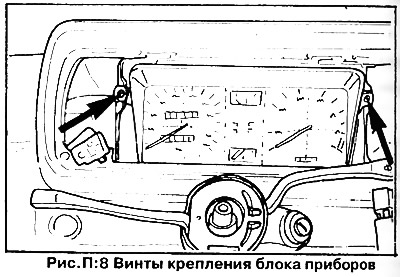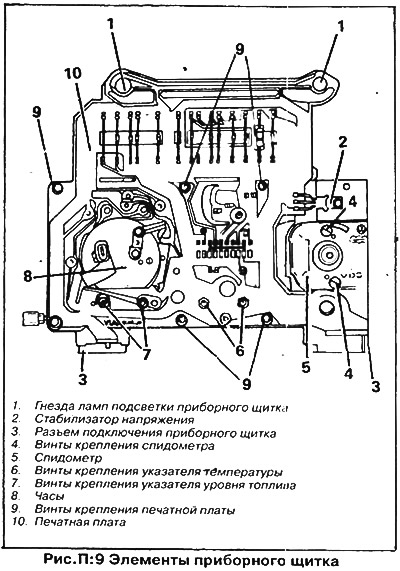Replacement
1. Before working on the instrument panel, be sure to disconnect the wire "masses" from the battery.
2. Remove the steering wheel (see chapter "Steering").
3. Remove handles from heater control levers.
4. Remove facing of the block of management of a heater.
5. Press the decorative window cover to install the radio (with the radio installed, it is necessary to remove its front panel and control knobs - see chapter "Optional equipment").
6. Remove the screws securing the instrument panel frame and pull the frame into the passenger compartment (rice. P:7).
Remove signal lamps and switches from the instrument panel frame, releasing the latches and pressing each element towards the passenger compartment
8. Remove the instrument panel bezel.
9. Remove the two screws securing the instrument panel (instrument cluster - fig. P:8).

10. Disconnect the speedometer cable from the back of the shield by squeezing the two plastic tabs together.
11. Disconnect the central connector and remove the instrument panel.
Installation of the instrument panel is carried out in the reverse order of removal. Check the operation of all switches, signal lamps and instruments.
Voltage stabilizer - replacement
On cars manufactured before August 1975, a voltage stabilizer was built into the fuel and temperature gauges. Since August 1975, a voltage stabilizer for fuel and temperature gauges has been installed as a separate device.
1. Remove the instrument panel as previously described.
2. Remove the stabilizer mounting screw, disconnect the wires and remove the voltage stabilizer (2, fig. P:9).

3. Installation of the voltage stabilizer is carried out in the reverse order.
PCB - Replacement
1. Remove the instrument panel and voltage regulator as described earlier.
2. Carefully remove the lamp holders from the sockets of the shield and the printed circuit board (1, fig. P:9).
3. Loosen the nuts and screws securing the printed circuit board and carefully remove the printed circuit board from the instrument panel (9, fig. P:9).
4. Installation of the printed circuit board is carried out in the reverse order.
Speedometer replacement
Remove the instrument panel as described above.
1. Remove the printed circuit board and voltage regulator.
2. Turn out bolts of the bearing plate and casing of devices (in the presence of) and remove the carrier plate and cover.
3. Turn out screws of fastening of a speedometer and remove it (4, fig. P:9).
4. Installation of a speedometer is carried out upside-down.
Replacing the tachometer and clock
The procedure for removing and installing the tachometer (in the presence of) and hours is similar to that described above for the speedometer.
Temperature gauge
If the pointer shows "NOT" ("heat" - the arrow is in the red zone), check that there is no actual engine overheating due to a malfunction in the cooling system (see chapter "Cooling system").
If the pointer keeps showing "COLD" ("low temperature"), this is due to a defective sensor, pointer or wiring.
Check the circuit with a test lamp with wires. To avoid damage to the temperature gauge, when checking, connect between the wire of the temperature sensor and "weight" control lamp for 12 V with a power of 6 watts. The sensor is located in a housing at the end of the cylinder head on the flywheel side.
Disconnect the wire from the sensor and connect between the wire and ground" control lamp. If the pointer moves into the zone "NOT", replace the defective sensor.
If the arrow remains in the position "COLD", the device itself or its wiring is faulty. Removing the fuel level and temperature gauges is carried out in the same way as the speedometer.

Visitor comments